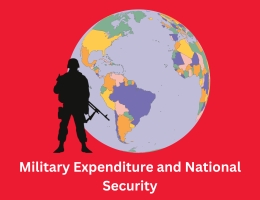
Historical Trends in Military Spending: Analyzing Changes in Military Budgets Over Time
- By admin --
- Saturday, 09 Mar, 2024
Introduction:
Military spending, a significant aspect of national budgets, has undergone dynamic changes over centuries, shaped by various factors including geopolitical tensions, technological advancements, and economic conditions. This essay delves into the historical trends of military spending, tracing its evolution from ancient civilizations to contemporary times.
Ancient and Medieval Periods:
In ancient civilizations such as Egypt, Mesopotamia, and China, military expenditures were primarily directed towards maintaining standing armies, fortifications, and conquests. Resources were allocated for weapons, armor, and logistics to expand territorial influence and protect borders. Similarly, during the medieval era, feudal societies relied on feudal levies and feudal obligations to support military endeavors. Kings and nobles financed wars through taxation and feudal dues, ensuring the loyalty of vassals by granting land and privileges.
Early Modern Period:
The early modern period witnessed significant transformations in military spending, driven by the rise of centralized nation-states and the emergence of professional armies. The Thirty Years' War (1618-1648) marked a turning point, as the devastation caused by prolonged conflict prompted states to develop more efficient fiscal systems to sustain their military capabilities. States like France under Louis XIV and England under the Tudors invested heavily in their armies and navies, laying the foundation for modern military institutions.
Industrial Revolution and Modernization:
The Industrial Revolution revolutionized military spending, with technological innovations leading to the mechanization of warfare. Industrialized nations like Britain, France, and Germany invested in mass production of arms, leading to exponential growth in military budgets. The arms race between European powers, particularly in the late 19th and early 20th centuries, fueled by colonial ambitions and geopolitical rivalries, resulted in unprecedented levels of military spending.
World Wars and Cold War:
The two World Wars of the 20th century profoundly influenced military expenditures. World War I saw a surge in defense spending as countries mobilized vast resources for the war effort, leading to massive debts and economic instability. The interwar period witnessed fluctuations in military budgets due to disarmament efforts and economic depression. However, the onset of World War II reignited military spending, with nations mobilizing entire economies for total war.
The Cold War era further intensified military expenditures as the United States and the Soviet Union engaged in a prolonged arms race. Nuclear proliferation and the development of strategic weapons systems drove defense budgets to unprecedented levels. The doctrine of mutually assured destruction (MAD) fueled continuous investments in nuclear arsenals, with military spending becoming a key determinant of global power dynamics.
Post-Cold War Era:
The end of the Cold War heralded a shift in military spending patterns, with many nations reducing defense budgets in response to changing geopolitical realities. The dissolution of the Soviet Union led to significant downsizing of military forces and defense industries in former communist bloc countries. However, the post-Cold War era also witnessed new security challenges such as terrorism, proliferation of weapons of mass destruction, and regional conflicts, prompting some nations to maintain or even increase defense expenditures.
Contemporary Trends:
In the 21st century, military spending continues to reflect evolving security threats and geopolitical dynamics. The War on Terror following the September 11 attacks prompted significant increases in defense budgets, particularly in the United States and its allies. Rising tensions in regions like the Middle East and Asia-Pacific have also contributed to growing military expenditures worldwide. Moreover, advancements in military technology, including cyber warfare, drones, and artificial intelligence, have reshaped defense priorities and resource allocation.
Conclusion:
The nature of global politics, technological innovation, economics is what makes the military expenditure rate change over periods. Ever since ancient times countries have been focusing on defense financing as one key element in their national policy and is still doing so in today’s modern society. The historical analysis shows that there were eras of extended funding followed by wars then decreases but new threats will determine future armies budgets.





